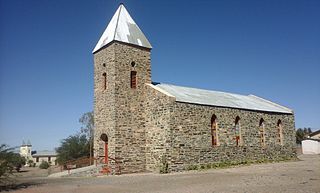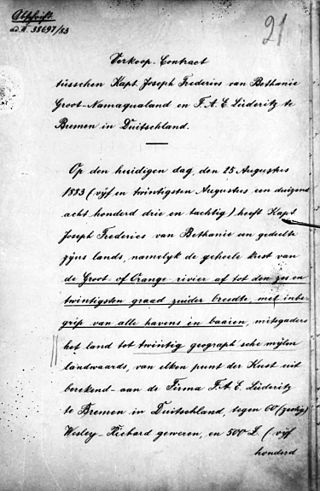Related Research Articles

Mahikeng, formerly known as Mafikeng and alternatively known as Mafeking, is the capital city of the North West province of South Africa.

David Livingstone was a Scottish physician, Congregationalist, pioneer Christian missionary with the London Missionary Society, and an explorer in Africa. Livingstone was married to Mary Moffat Livingstone, from the prominent 18th-century Moffatt missionary family. Livingstone came to have a mythic status that operated on a number of interconnected levels: Protestant missionary martyr, working-class "rags-to-riches" inspirational story, scientific investigator and explorer, imperial reformer, anti-slavery crusader, and advocate of British commercial and colonial expansion. As a result, Livingstone became one of the most popular British heroes of the late 19th-century Victorian era.
The following lists events that happened during 1845 in South Africa.

Robert Moffat was a Scottish Congregationalist missionary to Africa ftom 1817–1870. He began his missionary career in South Africa at the age of twenty-one. Moffat was married to Mary Moffat, the parents of Mary Moffat Livingstone and the father-in-law of David Livingstone. While doing missionary work at the mission at Kuruman Moffat was the first to translate and have printed the Bible into the Sechuana language While in Africa Moffat devoted much of his time preaching the gospel and discussing the Bible and also taught many of the natives how to read and write. Moffat's missionary career in Africa spanned a total of fifty-four years.

Bethanie is a village in the ǁKaras Region of southern Namibia. It is one of the oldest settlements in the country. Bethanie is situated on the C14 road between Goageb and Walvis Bay, 100 km west of Keetmanshoop. It has a population of about 2,000.
Ga-Rankuwa is a large settlement located about 37 km north-west of Pretoria. Provincially it is in Gauteng province, but it used to fall in Bophuthatswana during the apartheid years, and under the North West province until the early 2000s.

George Grenfell (21 August 1849, in Sancreed, Cornwall – 1 July 1906, in Basoko, Congo Free State was a Cornish missionary and explorer.
The Berlin Missionary Society (BMS) or Society for the Advancement of evangelistic Missions amongst the Heathen was a German Protestant (Lutheran) Christian missionary society that was constituted on 29 February 1824 by a group of pious laymen from the Prussian nobility.

Timothy Richard was a Welsh Baptist missionary to China, who influenced the modernisation of China and the rise of the Chinese Republic.
Jean Pierre Pellissier was a missionary from the Paris Evangelical Missionary Society to Southern Africa.

Botshabelo in the district of Middelburg, in Mpumalanga Province, South Africa, originated as a mission station established by Alexander Merensky of the Berlin Missionary Society (BMS), in February 1865 in what was then the Transvaal Republic (ZAR). Merensky had fled with a small number of parishioners following the attacks on his previous mission station, Ga-Ratau, by the soldiers of Sekhukhune, the king of the baPedi. Within a year of having established the mission station, the population had grown to 420 persons.
Richard Miles was a Motswana (Tswana) catechist and preacher "to the native tribes beyond the border" in South Africa.

Reverend Johann Heinrich Schmelen, born Johann Hinrich Schmelen was a German missionary and linguist who worked in South Africa and South-West Africa. Traveling through the area of today's northern South Africa and central and southern Namibia he founded the mission stations at Bethanie and Steinkopf and discovered the natural harbour at Walvis Bay. Together with his wife Zara he translated parts of the Bible into Khoekhoegowab (Damara/Nama) and published a dictionary.
The Revd George Mitchell was a missionary priest of the Anglican Church serving in the Free State, South Africa, from 1864, and afterwards at Kimberley, who pioneered early translation of liturgical Epistles and Gospels and portions of the Book of Common Prayer into Setswana. He was born near Mintford in England in 1835 and died in Kimberley, South Africa.

Bethanie is a town in Bojanala District Municipality in the North West province of South Africa.

Joseph Frederiks II, Nama name: ǃKhorebeb-ǁNaixab was a Captain of the ǃAman, a subtribe of the Orlam. He became Captain when his uncle and stepfather David Christian Frederiks was killed in 1880 in the Battle of Otjikango.

Fort Merensky, also called Fort Wilhelm, stands on a prominent hill in a commanding position near Botshabelo, a former Berlin Mission Station (BMS), 13 kilometers from Middelburg on the road to Groblersdal. It was built in order to protect the mission's convert from attacks by the local Bantu tribes using dry wall construction.

The Church Missionary Society in China was a branch organisation established by the Church Missionary Society (CMS), which was founded in Britain in 1799 under the name the Society for Missions to Africa and the East; as a mission society working with the Anglican Communion, Protestant, and Orthodox Christians around the world. In 1812, the organization was renamed the Church Missionary Society. The missions were financed by the CMS with the local organisation of a mission usually being under the oversight of the Bishop of the Anglican diocese in which the CMS mission operated.
Hans Christian Knudsen was a Norwegian missionary and painter. He was a pioneer Rhenish Missionary pioneer and scholar of Khoekhoe.

Hermann Theodor Wangemann was a German theologian and missionary.
References
- 1 2 Schoeman, K. 1985. Die huis van die armes: die Berlynse Sendinggenootskap in die OVS, 1833-1869, pp 67-76
- ↑ Martin Meredith (2008-09-01). Diamonds, Gold, and War: The British, the Boers, and the Making of South Africa. PublicAffairs. p. 23. ISBN 978-1-58648-641-9.
- ↑ Zöllner, Linda; Heese, J.A. (1984). The Berlin Missionaries in South Africa and their Descendants. Pretoria: Human Sciences Research Council, Institute for Historial Research. p. 466. ISBN 0796900108.
- ↑ Richard Miles: Motswana preacher "to the native tribes beyond the border,